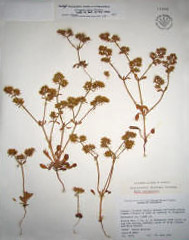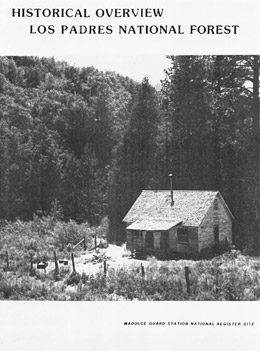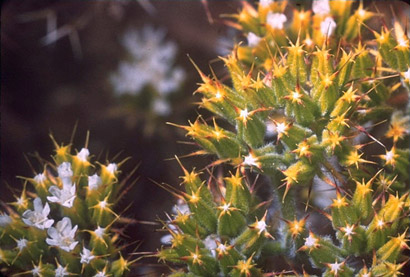Chorizanthe blakleyi
- Sensitive – U.S. Forest Service
- Rare Plant Rank 1B.3 – California Native Plant Society
- G2 Imperiled – NatureServe (2016)
In memory of E.R. “Jim” Blakley, 1924-2008
The story of Blakley’s spineflower is as much about the plant as it is about the man whose name precedes it.
“This distinctive species is named for my good friend, E. R. “Jim” Blakely, a real lover of plants, whether they flourish in Nature’s garden or come under his conscientious care in a botanic garden.”
That’s how Clare Hardham, a Paso Robles botanist, concluded her report of a new plant species found on the north slope of the Sierra Madre Mountains in Santa Barbara County in 1963. The plant was found by Jim Blakley, the noted historian, author, backcountry explorer, and – most of all – dear friend of the Santa Barbara backcountry and the Los Padres National Forest. Jim passed away in November 2008 at the age of 84. The many footsteps he took throughout the Los Padres National Forest – and the spineflowers that sprout each year bearing his name – will serve as a lasting tribute to his life’s adventures.
 It was June 29, 1963 when Jim first stumbled upon this distinct member of the buckwheat family while exploring a sandy opening in the chaparral near McPherson Peak. He gathered some specimens, brought them back to the Santa Barbara Botanic Garden where he lived and worked as a botanist, and soon found that the shape of its flowers were different than any other spineflower on record. The following year, Jim’s discovery was formally announced in Leaflets of Western Botany under the headline “A NEW CALIFORNIA CHORIZANTHE.”
It was June 29, 1963 when Jim first stumbled upon this distinct member of the buckwheat family while exploring a sandy opening in the chaparral near McPherson Peak. He gathered some specimens, brought them back to the Santa Barbara Botanic Garden where he lived and worked as a botanist, and soon found that the shape of its flowers were different than any other spineflower on record. The following year, Jim’s discovery was formally announced in Leaflets of Western Botany under the headline “A NEW CALIFORNIA CHORIZANTHE.”
Blakley’s Adventures
Jim’s discovery of a new species of plant should come as no surprise – it was one of many secrets he uncovered while exploring every trail, waterfall, rock outcrop, and swimming hole in the southern Los Padres, from the Piru to the Sisquoc. His thirst for adventure began as a child, on camping trips with his father in the mountains of Arizona. Later, after earning his B.S. in Botany at Arizona State University, Jim found his way to Santa Barbara, working as a botanist and caretaker at the town’s botanic garden and living in the garden’s cottage for thirty years.
During that time, he became known as one of the foremost naturalists and historians of the southern Los Padres, hiking in the mountains with friends and family and working alongside legends of local natural history like Tom Diblee, Dick Smith, Campbell Grant, and Clifton Smith. Spanning nearly a half-centry of hiking expeditions, he served as a scoutmaster, a leader of the Los Padres Interpretive Association, a guide on the annual Coastal Beachwalk, and a member of several trail organizations. Over the years he collected thousands of documents, photos, articles, memorabilia, and oral histories from local old-timers chronicling the natural history of the Los Padres. Jim was a founding member of the Santa Barbara County Archaeological Society and a supporter of Los Padres ForestWatch.
 Always eager to share his knowledge of the backcountry with others, he wrote A Traveler’s Guide to Highway 33 in 2004. “His love for the backcountry shines through his writing,” remarked a forest archaeologist in introducing Jim’s Historical Overview of the Los Padres National Forest in 1985, which today remains as the only modern historical account of the entire southern Los Padres National Forest.
Always eager to share his knowledge of the backcountry with others, he wrote A Traveler’s Guide to Highway 33 in 2004. “His love for the backcountry shines through his writing,” remarked a forest archaeologist in introducing Jim’s Historical Overview of the Los Padres National Forest in 1985, which today remains as the only modern historical account of the entire southern Los Padres National Forest.
Blakley’s Spineflower
Blakley’s spineflower occurs on flats and north-facing slopes in sandy, sometimes rocky, open areas in chaparral or pinyon-juniper woodland. It’s fitting that the spineflower that bears his name is found only on the Los Padres National Forest and adjacent lands along the Sierra Madre Ridge, where Jim spent much of his time. Chorizanthe blakleyi is found only near the White Oaks Guard Station, Aliso Canyon, Montgomery Potrero, and McPherson Peak.
Blakley’s spineflower is an annual, sprouting anew every year and displaying small white flowers in April and June. The hairy stem is yellow-green and grows from 2 to 6 inches tall. Nobody knows for sure how many plants remain, but Blakley’s spineflower is considered quite rare, disappearing altogether in years of low rainfall and becoming more abundant in wetter years. According to Forest Service data, possibly less than one thousand of these plants remain.
Preserving a Legacy
 Chorizanthe blakleyi is threatened by vehicles, recreation activities, road maintenance, and nonnative plants. On the Los Padres National Forest, the primary threat is from road and trail maintenance – all four populations on the Los Padres are found along roads, trails, and other high-use areas. In addition, the Forest Service has determined that livestock can trample spineflower plants, which is of particular concern during the plant’s growing season. Spineflower habitat has also been fragmented by oil development in the Cuyama Valley foothills. Because of these threats and the plant’s limited distribution, the Forest Service has placed Blakley’s spineflower on its Sensitive Species list, and the California Native Plant Society classifies the plant as “rare.”
Chorizanthe blakleyi is threatened by vehicles, recreation activities, road maintenance, and nonnative plants. On the Los Padres National Forest, the primary threat is from road and trail maintenance – all four populations on the Los Padres are found along roads, trails, and other high-use areas. In addition, the Forest Service has determined that livestock can trample spineflower plants, which is of particular concern during the plant’s growing season. Spineflower habitat has also been fragmented by oil development in the Cuyama Valley foothills. Because of these threats and the plant’s limited distribution, the Forest Service has placed Blakley’s spineflower on its Sensitive Species list, and the California Native Plant Society classifies the plant as “rare.”
ForestWatch is working to protect Blakley’s spineflower and other rare plants and animals on the Los Padres National Forest by demanding stringent protections for its habitat. As a critical component of the rich diversity of life in the Los Padres and an enduring tribute to our friend Jim Blakley, a true forest legend, Chorizanthe blakleyi deserves nothing less.









